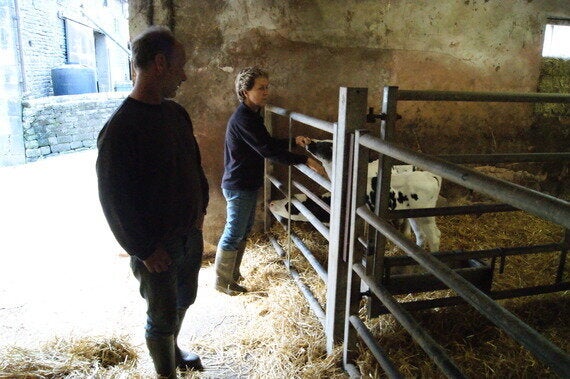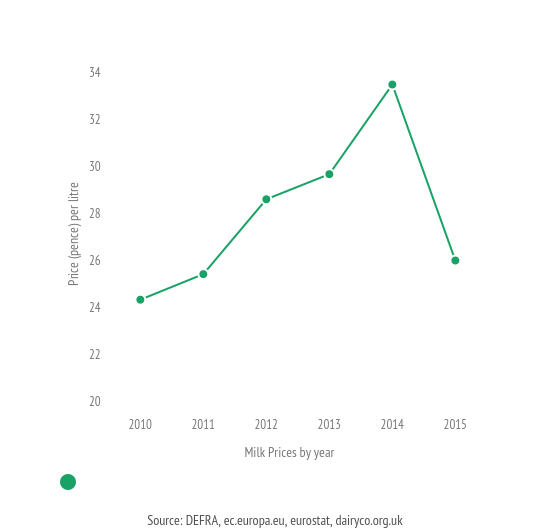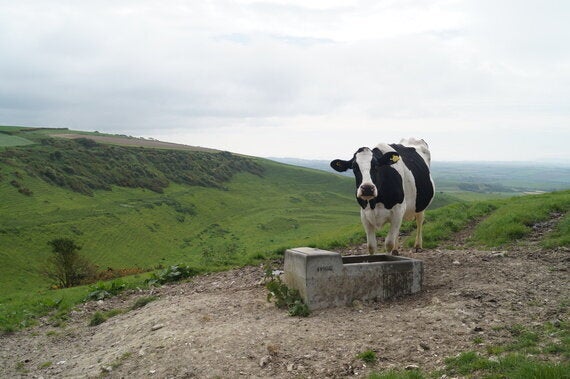Every day, dairy farmers Andrew and Jane Charlesworth lose £130. They're not even close to making a profit. "Milk has become a throwaway commodity," says Andrew. "It's cheaper than water."
The Charlesworth's story is typical. Dairy farmers up and down the country are struggling.
The situation is becoming desperate - the Samaritans have reported a rise in the number of dairy farmers calling, asking for help and local papers are spattered with reports of farmer-suicides.

The Charlesworth's farm is just outside Sheffield. Twenty years ago, there used to be 19 dairy farmers in this valley. Now there are three. The value of milk has been volatile since Margaret Thatcher abolished the Milk Marketing Board, which guaranteed a minimum price.
Now dairy farmers are at the mercy of processors - who, in turn, are under pressure from retailers, such as Tesco or Aldi, to keep prices low.
Milk prices have fallen drastically since early 2014

Andrew says dairy farmers have become ammunition in a price war between supermarkets. They use milk as a "loss leader" - selling it below the market-cost to entice customers into the store where they're likely to buy other things. "But why should they use our product? Why can't they use something else?" says Andrew, frustrated. "Sometimes I want to scream."
Experts have suggested small dairy farms evolve into mega-dairies to make the industry more efficient. Mega-dairies are usually home to more than 1,000 cows and Andrew worries that industrial methods aren't as kind: "It might be more efficient, but think about the poor animals."
Dairy farmers caught up in supermarket price war
The Charlesworths are attached to their herd of 100 cows; they know them all by name. They talk about "fiery Jess" and Melvin, who's just had twins. They don't want the process to become more anonymous. Andrew looks out across the rolling Sheffield landscape: "Look at them out in the field," he says. "Don't they look marvellous with the sun on their backs?" In mega-dairies, cows often never go outside.
They believe that if consumers paid just 10p more for their milk, the industry could survive the way it is. "Ten pence is nothing to them, but to us that would make a massive difference," says Jane.
Yet Dr Steve Davies of the Institute of Economic Affairs argues that larger markets are more efficient and cheaper for consumers: "Why should people give up some of their income in higher prices or taxes in order to preserve a particular historic kind of agriculture? The goal of producing milk is so that people can consume it. Not so there will be jobs in the dairy industry."
Andrew and Jane have been picketing outside processors and leafleting at supermarkets. They also have links to Farmers for Action, a grassroots organisation that fights against low milk prices. But while the couple campaign for better conditions in the industry's future, they're being forced to think of the present and diversify their business to stay afloat for now.
Many UK farmers reject 'more efficient' mega dairies
"We sell fat cattle [for beef] and our own corn, that's why we're still going," says Jane. "I've no idea how people who rely only on dairy cows are still managing to survive."
Farmers who don't like the idea of mega dairies are being forced to find new ways of making money to financially sustain their business. Dairy farms with B&Bs and farm shops attached have become common but Harold Woolgar from Farmers for Action is not optimistic about these opportunities. He thinks the sheer volume of struggling dairy farms means they can't all diversify: "There's only so many farm shops you can have in one area before the market is saturated."
"I've no idea how people who rely only on dairy cows are still managing to survive." - Jane Charlesworth
Rhian Price, deputy livestock editor at Farmers Weekly, says: "Converting milk into manufactured products such as ice-cream and yoghurt is a way for farmers to add value to their basic commodity.
"One of the most unusual forms of dairy diversification I've heard of is someone who is turning milk into vodka, but renewable energy, farm tourism and ice-cream remain firm favourites."
Farmers diversify business by making vodka and icecream
Emyr Davis is yet another farmer struggling - last year he would get 36p per litre of milk but now that price has dropped to 23p. He says: "I've always been able to make a living from milking but now we're seeing a slow death of the industry. We need a sustainable milk price."
Davis is slightly protected from this year's crash in milk prices because he has installed two wind turbines on his farm in West Wales. He owns one and Canadian company, Endurance Wind Power owns the other, renting the land from him.
"The turbines have made a big difference to my income," he says.

Endurance has 750 wind turbines installed in the UK, 90 per cent of them on farms. Brett Pingree, VP Commercial of Endurance, says: "Dairy farmers are barely making ends meet but wind-turbines give them certainty over energy prices and diversify their income. For farmers, energy can be the biggest cost. They can use the turbines to cap this and protect themselves from the volatility of energy prices."
Recently more dairy farmers than usual have been going to Endurance. If their location is windy enough, they have two options: they can either buy the turbine outright or they can lease the farmland to the developer, either Endurance or another company.
Renewable energy offers lucrative alternative
Once farmers have paid back any money they borrowed for the installation, they can earn up to £80,000 each year if they own the turbine outright. But Pingree says the land-rental option is becoming more and more popular because feed-in tariff rates - a scheme in which the government pays for the electricity generated - are declining. The annual fee for land-rental varies depending on the farm's access to wind but Pingree says farmers who lease their land make £5-10,000 per year on average.
But some dairy farmers take diversification one-step further, transforming their business beyond recognition. Hannah and Bruce Deane have been running their Norfolk Bed and Breakfast, Dairy Barns, for the last ten years. They were dairy farmers but struggled to make their business viable.
"The only practical thing we could do was sell the herd and change direction." - Hannah Deane
Located close to the Norfolk coast, Hannah says they decided to use their obvious assets - the empty brick barns where the milking parlour used to be - to turn the farm into a tourist destination.
She says: "We got out of milk production in November 2000. The reason was simple: we couldn't make money at it any more and were working seven days a week so something had to change. We either had to expand the dairy herd to gain economies of scale or sell-up and start a new venture. The only practical thing we could do was sell the herd and change direction."